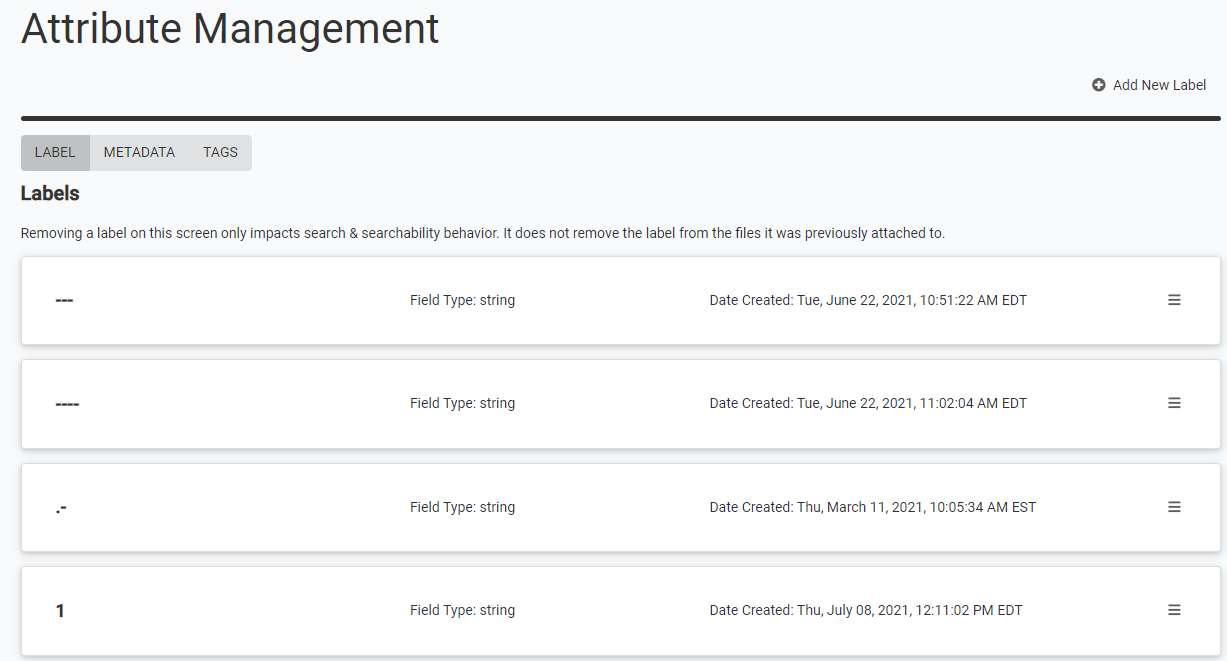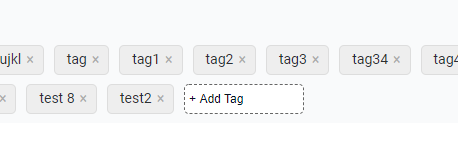Manage and Apply Attributes
Without changing actual data in your files, you can use these attributes to annotate your files and trigger pipelines:
- Metadata
- Tags
- Labels
Although metadata, tags, and labels seem to be very similar, they are designed for different usages. For details, review the Basic Concepts page.
You can add, edit, and delete metadata, tags, and labels in multiple places in the Tetra Data Platform (TDP), such as when you want to:
- View search results
- Add files from a Tetra Agent (you can add metadata, but not labels)
- View pipeline processing details for a file
- Add or edit a connector
How to Manage Attributes
You can view, add, edit, and delete attributes in the Attribute Management page. Custom metadata and tags are available to all users. However, you can set a more restrictive level for data integrity based on your company's use case, for example, the feature may only be accessible to Admins.
View Attributes
To view labels, metadata, and tags:
- From the Tetra Data Platform page, click Attribute Management from the left side of the page:

Attribute Management menu item
The Attribute Management page displays:

Attribute Management page
- To view the existing labels, metadata, and tags in the Tetra Data Platform, you can click each of the three buttons at the top of the page to display the specific attribute information.
Create a New Label
To create a a new label:
- From the Attribute Management page, click Label at the top of the page to display the labels.
- Click + Add New Label at the top right corner.
- In the Create New Label Field dialog, enter the name for the new label.
Label Values
Label values must be less than 128 characters, and can only include: letters, numbers, spaces, and these symbols: +, -, ., or _.
- Click Save to save and add the new label to the list.
Delete a Label
Label Removal Behavior
Removing a label from this page only impacts search and searchability behavior. It does not remove the label from the files it was previously attached to.
To delete a label:
- From the Attribute Management page - Labels view, click the small menu icon to the right of the label entry you want to delete.
- A delete trash can icon displays to the right of the menu.
- Click Delete.
- A warning message displays asking you to confirm the deletion. Click OK to confirm and delete the label.
Add a New Metadata Field
There are two types of metadata used within the TDP:
Default metadata is collected automatically and is immutable within the TDP. Examples include File ID, Created Date, and Source Type. These fields are related to the TDP. As a result, the Created Date represents when the file was first uploaded to the Data Lake; not when the file was created by its original source.
Custom metadata is user-defined and editable. You can use custom metadata to enhance the default metadata by adding organization-specific information.
You can apply custom metadata to files automatically and manually. When setting up any new data source (for example, IoT or DataHub) you can specify a custom metadata field and value to attach to all incoming files from that source. After you complete this set up, it will continue to run automatically until you edit the source and remove the custom metadata.
Custom metadata is available to all users. However, you can set it to a more restrictive level for data integrity based on your use case (for example, only accessible to privileged user or admins).
To add a new metadata field:
- From the Attribute Management page, click Metadata at the top of the page to display the metadata.
- Click + Add New Metadata Field at the top right corner.
- In the Create New Metadata Field dialog, enter the name for the new metadata.
Metadata Values
Metadata field names can consist of these characters: * ^[0-9a-zA-Z-_+ ]+$
Metadata values can be any combination of the following:
- All alphanumeric characters
- spaces
- plus sign
- dash
- period
- underscore
- comma
- forward slash
- Click Save to save and add the new metadata field to the list.
Edit a Metadata Field
To edit a metadata field:
- From the Attribute Management page, click the small menu icon to the right of the metadata entry you want to edit.
- An pop-up dialog displays with two icons: Edit and Delete.
- Click Edit.
- From the Edit Metadata Field dialog, update the metadata name.
- Click Save to save and add the updated metadata to the list.
Delete a Metadata Field
Metadata Removal Behavior
Removing a metadata field from this page only impacts search and searchability behavior. It does not remove the label from the files it was previously attached to.
To delete a metadata field:
- From the Attribute Management page - Metadata view, click the small menu icon to the right of the metadata entry you want to delete.
- A delete trash can icon displays to the right of the menu.
- Click Delete.
- A warning message displays asking you to confirm the deletion. Click OK to confirm and delete the metadata.
Add a New Tag
You can use custom tags to organize datasets and perform batch operations. You can apply custom tags to files automatically and manually. When setting up any new data source (for example, IoT or DataHub) you can specify a custom tag to attach to all incoming files from that source. After you complete this set up, it will continue to run automatically until you edit the source and remove the custom tag.
Custom tags are available to all users. However, you can set it to a more restrictive level for data integrity based on your use case (for example, only accessible to privileged user or admins).
To add a new tag:
- From the Attribute Management page, click Tags at the top of the page to display the tags.
- Click the rectangle at the end of the list of tags with the text: + Add Tag and add your tag text.

Tag list
Tag Values
Tag names can consist of the following characters:
- All alphanumeric characters
- spaces
- plus sign
- dash
- period
- underscore
- forward slash
- Press Return or Enter from your device to save and add the new tag to the list. The new tag is alphabetized and added in the correct order in the list.
You cannot edit a tag. To attach a different tag, must delete it and then add a new one.
Delete a Tag
To delete a tag:
- From the Attribute Management page - Tag view, click the x to the right of the tag name you want to delete.
- The tag is removed from the list.
How to Apply Attributes to Files
You can apply these attributes to files:
- Metadata
- Tags
- Labels
You can apply these attributes to files using this widget which is available from many places within the Tetra Data Platform user interface. This example shows the labels attribute:

Labels widget
To apply an attribute (label, metadata, or tag) to a file:
- From the page or pop-up dialog that has the option to add an attribute, click Advanced Fields to expand the page. This example shows the metadata attribute:

Metadata and Tags widget
- Depending on which attribute you want to add, click +Add Metadata or click +Add Tag.
- To add metadata, you can either:
- Add a new metadata field by entering a name in the Metadata Field text box. "Create:" displays in front the text you just typed. Click the text Create: [your new field] to create the new metadata field.
or - Use an existing field by clicking the down arrow in the Metadata Field text box and selecting the metadata field name from the list that appears.
- Add a new metadata field by entering a name in the Metadata Field text box. "Create:" displays in front the text you just typed. Click the text Create: [your new field] to create the new metadata field.
- Enter a value in the Metadata Value text box, then press Enter.
Updated almost 2 years ago
